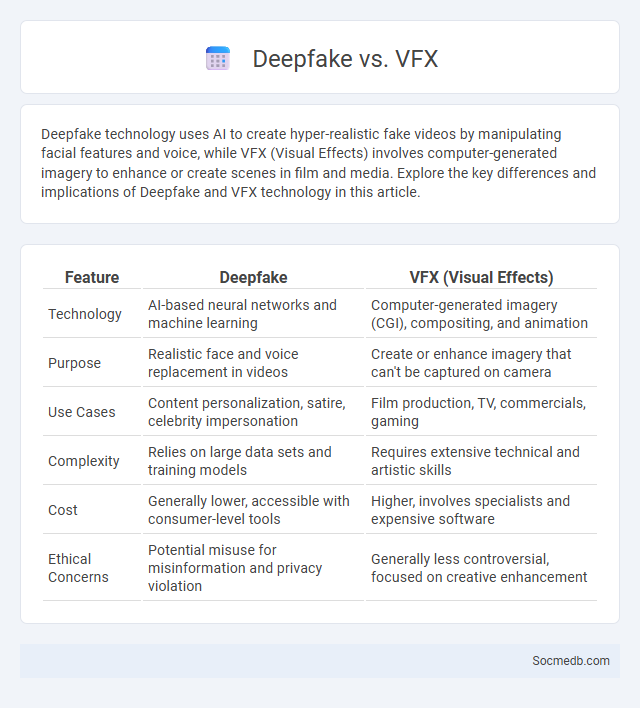
Photo illustration: Deepfake vs VFX
Deepfake technology uses AI to create hyper-realistic fake videos by manipulating facial features and voice, while VFX (Visual Effects) involves computer-generated imagery to enhance or create scenes in film and media. Explore the key differences and implications of Deepfake and VFX technology in this article.
Table of Comparison
| Feature | Deepfake | VFX (Visual Effects) |
|---|---|---|
| Technology | AI-based neural networks and machine learning | Computer-generated imagery (CGI), compositing, and animation |
| Purpose | Realistic face and voice replacement in videos | Create or enhance imagery that can't be captured on camera |
| Use Cases | Content personalization, satire, celebrity impersonation | Film production, TV, commercials, gaming |
| Complexity | Relies on large data sets and training models | Requires extensive technical and artistic skills |
| Cost | Generally lower, accessible with consumer-level tools | Higher, involves specialists and expensive software |
| Ethical Concerns | Potential misuse for misinformation and privacy violation | Generally less controversial, focused on creative enhancement |
Introduction to Synthetic Media Technologies
Synthetic media technologies leverage artificial intelligence to create, manipulate, and generate realistic digital content, including images, videos, and audio, revolutionizing social media engagement. These technologies enable the production of hyper-realistic avatars, deepfake videos, and AI-generated text, enhancing content personalization and immersive user experiences. Businesses and creators utilize synthetic media to boost authenticity, automate content creation, and drive innovative marketing strategies across social platforms.
Defining Deepfake: AI-Powered Video Manipulation
Deepfake technology uses advanced artificial intelligence algorithms to create hyper-realistic videos that manipulate or fabricate visual and audio content, making it difficult to distinguish from genuine footage. These AI-powered video manipulations leverage deep learning techniques such as generative adversarial networks (GANs) to seamlessly alter facial expressions, speech, and actions of individuals within videos. Social media platforms face significant challenges in addressing deepfake content due to its potential for misinformation, identity theft, and undermining trust in digital media.
Understanding VFX: Traditional Visual Effects Explained
Understanding VFX involves exploring how traditional visual effects create immersive scenes using practical techniques like miniatures, matte paintings, and optical compositing. These methods laid the foundation for modern digital effects by combining live-action footage with crafted visual elements to enhance storytelling realism. Social media platforms amplify VFX knowledge sharing, allowing creators to showcase traditional techniques and engage with global audiences interested in film production artistry.
Deepfake vs VFX: Key Technological Differences
Deepfake technology uses AI algorithms to manipulate facial features and voices, creating hyper-realistic synthetic media that can deceive viewers. VFX, or Visual Effects, relies on computer-generated imagery and compositing techniques to enhance or fabricate scenes in movies and advertisements without necessarily mimicking real individuals. Understanding these key technological differences helps you discern authentic content from manipulated visuals on social media platforms.
Use Cases: Where Deepfakes and VFX Are Applied
Deepfakes and VFX are extensively utilized in social media marketing to create hyper-realistic promotional content that captures audience attention and boosts engagement rates. Influencers and content creators leverage these technologies to produce immersive storytelling, virtual try-ons, and augmented reality filters that enhance user interaction. Brands also deploy deepfakes and VFX for personalized advertisements and viral campaigns that significantly increase reach and conversion metrics.
Ethical Considerations and Risks
Social media platforms present ethical considerations such as privacy concerns, data security, and the spread of misinformation that can harm individuals and communities. Your digital footprint can be exploited by third parties, making it essential to manage permissions and share content cautiously. Understanding these risks ensures responsible use and protects your online reputation.
Detecting Deepfakes: Tools and Techniques
Detecting deepfakes on social media platforms relies on advanced tools like AI-powered algorithms and machine learning models designed to analyze video and image inconsistencies. Techniques include forensic analysis of facial movements, eye blinking patterns, and audio-visual synchronization to identify manipulated content. Collaboration between tech companies and research institutions enhances the development of real-time detection systems, improving the accuracy of deepfake identification and preventing misinformation spread.
Industry Impact: Film, Media, and Beyond
Social media has revolutionized the film and media industry by enabling direct audience engagement, real-time feedback, and viral marketing campaigns that significantly boost box office success. Platforms like Instagram and TikTok have become essential for content creators and studios to promote trailers, behind-the-scenes footage, and interactive experiences. Beyond entertainment, social media drives cultural trends, influences content production, and fosters global collaborations across diverse media sectors.
The Future of Synthetic Media
Synthetic media, powered by advanced AI technologies such as deepfakes and generative adversarial networks (GANs), is transforming the social media landscape by enabling hyper-realistic content creation and personalized user experiences. Platforms are integrating synthetic avatars, virtual influencers, and AI-generated videos to engage audiences while raising critical concerns around authenticity, misinformation, and digital ethics. Emerging regulations and AI detection tools will play a crucial role in balancing innovation with transparency and trustworthiness in the future of social media.
Conclusion: Choosing Between Deepfake and VFX
Deepfake technology offers hyper-realistic, AI-generated content that revolutionizes personalized social media experiences, while VFX provides controlled, high-quality visual enhancements primarily used in professional productions. Selecting between deepfake and VFX depends on the desired outcome: deepfakes excel in automated, cost-effective content creation, whereas VFX ensures precise, artistic effects with greater manual control. Social media platforms must weigh authenticity, ethical considerations, and technical capabilities when integrating these advanced visual tools to optimize audience engagement.
 socmedb.com
socmedb.com